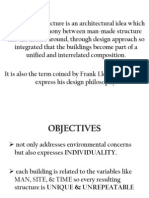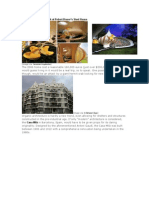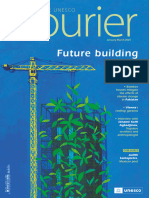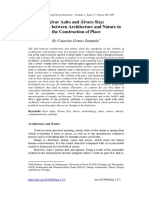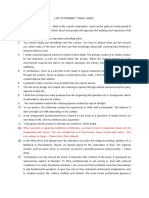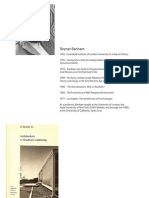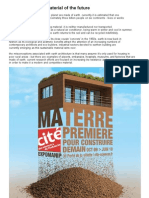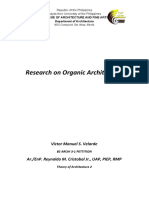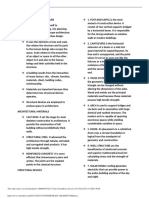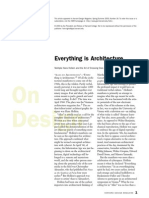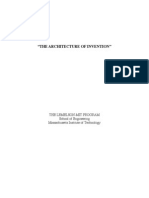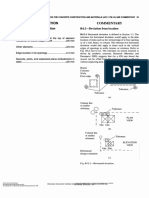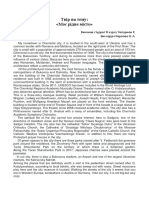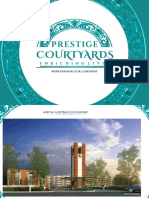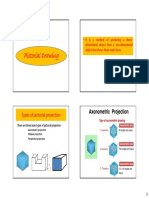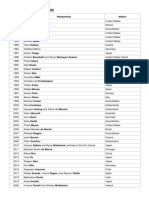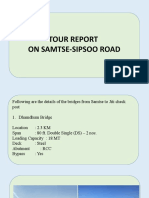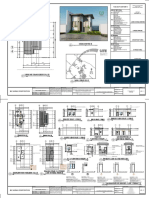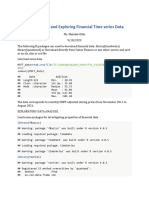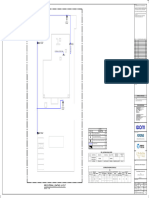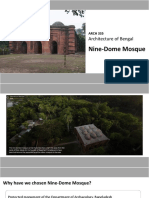Biomimetic Architecture
Biomimetic Architecture
Uploaded by
stipsa592Copyright:
Available Formats
Biomimetic Architecture
Biomimetic Architecture
Uploaded by
stipsa592Original Description:
Copyright
Available Formats
Share this document
Did you find this document useful?
Is this content inappropriate?
Copyright:
Available Formats
Biomimetic Architecture
Biomimetic Architecture
Uploaded by
stipsa592Copyright:
Available Formats
Biomimetic architecture
Biomimetic architecture is a contemporary philosophy
of architecture that seeks solutions for sustainability in
nature, not by replicating the natural forms, but by understanding the rules governing those forms. It is a multidisciplinary approach to sustainable design that follows a
set of principles rather than stylistic codes. It is part of a
larger movement known as biomimicry, which is the examination of nature, its models, systems, and processes
for the purpose of gaining inspiration in order to solve
man-made problems.
incorporated natural motifs into design such as the treeinspired columns. Late Antique and Byzantine arabesque
tendrils are stylized versions of the acanthus plant.[1]
Varros Aviary at Casinum from 64 BC reconstructed a
world in miniature.[2] A pond surrounded a domed structure at one end that held a variety of birds. A stone colonnaded portico had intermediate columns of living trees.
The Sagrada Famlia church by Antoni Gaudi begun in
1882 is a well-known example of using natures functional forms to answer a structural problem. He used
columns that modeled the branching canopies of trees to
solve statics problems in supporting the vault.[3]
History
Sagrada-familia-arches2
Organic architecture uses nature-inspired geometrical
forms in design and seeks to reconnect the human with his
or her surroundings. Kendrick Bangs Kellogg, a practicing organic architect, believes that above all, organic architecture should constantly remind us not to take Mother
Nature for granted work with her and allow her to guide
your life. Inhibit her, and humanity will be the loser.[4]
This falls in line with another guiding principle, which is
that form should follow ow and not work against the dynamic forces of nature.[5] Architect Daniel Liebermanns
commentary on organic architecture as a movement highlights the role of nature in building: a truer understanding of how we see, with our mind and eye, is the
foundation of everything organic. Mans eye and brain
evolved over aeons of time, most of which were within the
vast untrammeled and unpaved landscape of our Edenic
biosphere! We must go to Nature for our models now,
that is clear![4] Organic architects use man-made solutions with nature-inspired aesthetics to bring about an
awareness of the natural environment rather than relying
on natures solutions to answer mans problems.
Birdhouse at Casinum
Architecture has long drawn from nature as a source of
inspiration. Biomorphism, or the incorporation of natural
existing elements as inspiration in design, originated possibly with the beginning of man-made environments and
remains present today. The ancient Greeks and Romans
1
CHARACTERISTICS
Metabolist architecture, a movement present in Japan
post-WWII, stressed the idea of endless change in the biological world. Metabolists promoted exible architecture and dynamic cities that could meet the needs of a
changing urban environment.[6] The city is likened to a
human body in that its individual components are created and become obsolete, but the entity as a whole continues to develop. Like the individual cells of a human
body that grow and die although human body continues
to live, the city, too, is in a continuous cycle of growth
and change.[7] The methodology of Metabolists views nature as a metaphor for the man-made. Kisho Kurokawas
Helix City is modeled after DNA, but uses it as a strucBioniccar 11
tural metaphor rather than for its underlying qualities of
its purpose of genetic coding.
Biomimetic architecture goes beyond using nature as inspiration for the aesthetic components of built form, but
instead seeks to use nature to solve problems of the buildings functioning. Biomimicry means to imitate life and
originates from the Greek words bios (life) and mimesis (imitate). The movement is a branch o of the new
science dened and popularized by Janine Benyus in her
1997 book Biomimicry: Innovation Inspired by Nature
as one which studies nature and then imitates or takes inspiration from its designs and processes to solve human
problems.[8] Rather than thinking of the building as a machine for living in, biomimicry asks architects to think of Box Fish on Cobblers Reef
a building as a living thing for a living being.
Characteristics
constant intake of resources to function), and rely on solar energy instead of fossil fuels. The design approach
can either work from design to nature or from nature to
design. Design to nature means identifying a design problem and nding a parallel problem in nature for a solution.
An example of this is the DaimlerChrysler bionic car that
looked to the boxsh to build an aerodynamic body.[10]
The nature to design method is a solution-driven biologically inspired design. Designers start with a specic biological solution in mind and apply it to design. An example of this is Stos Lotusan paint, which is self-cleaning,
an idea presented by the lotus ower, which emerges clean
from swampy waters.[11]
Biomimetic architecture uses nature as a model, measure
and mentor to solve problems in architecture. It is not
the same as biomorphic architecture, which uses natural existing elements as sources of inspiration for aesthetic components of form. Instead, biomimetic architecture looks to nature as a model to imitate or take inspiration from natural designs and processes and applies
it to the man-made. It uses nature as a measure meaning
biomimicry uses an ecological standard to judge the eciency of human innovations. Nature as a mentor means
that biomimicry does not try to exploit nature by extracting material goods from it, but values nature as something 2.1
humans can learn from.[9]
Architectural innovations that are responsive to architecture do not have to resemble a plant or an animal. Where
form is intrinsic to an organisms function, then a building
modeled on a life forms processes may end up looking
like the organism too. Architecture can emulate natural
forms, functions and processes. Though a contemporary
concept in a technological age, biomimicry does not entail
the incorporation of complex technology in architecture.
In response to prior architectural movements biomimetic
architecture strives to move towards radical increases in
resource eciency, work in a closed loop model rather
than linear (work in a closed cycle that does not need a
Three Levels of Mimicry
Biomimicry can work on three levels: the organism, its
behaviors, and the ecosystem. Buildings on the organism level mimic a specic organism. Working on this
level alone without mimicking how the organism participates in a larger context may not be sucient to produce a building that integrates well with its environment
because an organism always functions and responds to a
larger context. On a behavior level, buildings mimic how
an organism behaves or relates to its larger context. On
the level of the ecosystem, a building mimics the natural
process and cycle of the greater environment. Ecosystem principles follow that ecosystems (1) are dependent
3.2
Behavior Level
on contemporary sunlight; (2) optimize the system rather
than its components; (3) are attuned to and dependent
on local conditions; (4) are diverse in components, relationships and information; (5) create conditions favorable to sustained life; and (6) adapt and evolve at dierent levels and at dierent rates.[12] Essentially, this means
that a number of components and processes make up an
ecosystem and they must work with each other rather than
against in order for the ecosystem to run smoothly. For
architectural design to mimic nature on the ecosystem
level it should follow these six principles.
3
3.1
Examples of Biomimicry in Architecture
Venus Flower Basket (sponge-labelled)
Organism Level
constructed of Ethylene Tetrauoroethylene (ETFE), a
material that is both light and strong.[14] The nal superOn the organism level, the architecture looks to the organ- structure weighs less than the air it contains.
ism itself, applying its form and/or functions to a building.
3.2 Behavior Level
On the behavior level, the building mimics how the organism interacts with its environment to build a structure
that can also t in without resistance in its surrounding
environment.
Termite mounds Namibia
Gherkin
Norman Fosters Gherkin Tower (2003) has a hexagonal
skin inspired by the Venus Flower Basket Sponge. This
sponge sits in an underwater environment with strong
water currents and its lattice-like exoskeleton and round
shape help disperse those stresses on the organism.[13]
The Eastgate Centre designed by architect Mick Pearce in
conjunction with engineers at Arup Associates is a large
oce and shopping complex in Harare, Zimbabwe. To
minimize potential costs of regulating the buildings inner
temperature Pearce looked to the self-cooling mounds of
African termites. The building has no air-conditioning or
heating but regulates its temperature with a passive cooling system inspired by the self-cooling mounds of African
termites.[15] The structure, however, does not have to look
like a termite mound to function like one and instead aesthetically draws from indigenous Zimbabwean masonry.
The Eden Project (2001) in Cornwall, England is a series of articial biomes with domes modeled after soap
bubbles and pollen grains. Grimshaw Architects looked
to nature to build an eective spherical shape. The re- The Qatar Cacti Building designed by Bangkok-based
sulting geodesic hexagonal bubbles inated with air were Aesthetics Architects for the Minister of Municipal Af-
5 SEE ALSO
Eastgate Centre, Harare, Zimbabwe
fairs and Agriculture is a projected building that uses the
cactuss relationship to its environment as a model for
building in the desert. The functional processes silently
at work are inspired by the way cacti sustain themselves
in a dry, scorching climate. Sun shades on the windows
open and close in response to heat, just as the cactus undergoes transpiration at night rather than during the day
to retain water.[16] The project reaches out to the ecosystem level in its adjoining botanical dome whose wastewater management system follows processes that conserve
water and has minimum waste outputs. Incorporating living organisms into the breakdown stage of the wastewater minimizes the amount of external energy resources
needed to fulll this task.[16] The dome would create a
climate and air controlled space that can be used for the
cultivation of a food source for employees.
3.3
Ecosystem Level
Building on the ecosystem level involves mimicking of
how the environments many components work together
and tends to be on the urban scale or a larger project with
multiple elements rather than a solitary structure.
The Cardboard to Caviar Project founded by Graham
Wiles in Wakeeld, UK is a cyclical closed-loop system
using waste as a nutrient.[17] The project pays restaurants
for their cardboard, shreds it, and sells it to equestrian
centers for horse bedding. Then the soiled bedding is
bought and put into a composting system, which produces
a lot of worms. The worms are fed to roe sh, which produce caviar, which is sold back to the restaurants. This
idea of waste for one as a nutrient for another has the potential to be translated to whole cities.[14]
the Namibian desert beetle to combat climate change in
an arid environment.[14] It draws upon the beetles ability to self-regulate its body temperature by accumulating
heat by day and to collect water droplets that form on its
wings. The greenhouse structure uses saltwater to provide evaporative cooling and humidication. The evaporated air condenses to fresh water allowing the greenhouse to remain heated at night. This system produces
more water than the interior plants need so the excess
is spewed out for the surrounding plants to grow. Solar
power plants work o of the idea that symbiotic relationships are important in nature, collecting sun while providing shade for plants to grow. The project is currently
in its pilot phase.
Lavasa, India is a proposed 8000-acre city by HOK (Hellmuth, Obata, and Kassabaum) planned for a region of India subject to monsoon ooding.[19] The HOK team determined that the sites original ecosystem was a moist deciduous forest before it had become an arid landscape. In
response to the season ooding, they designed the building foundations to store water like the former trees did.
City rooftops mimic native the banyan g leaf looking to
its drip-tip system that allows water to run o while simultaneously cleaning its surface.[20] The strategy to move
excess water through channels is borrowed from local harvester ants, which use multi-path channels to divert water
away from their nests.
4 Criticisms
Biomimicry has been criticized for distancing man from
nature by dening the two terms as separate and distinct
from one another. The need to categorize human as distinct from nature upholds the traditional denition of nature, which is that it is those things or systems that come
into existence independently of human intention. Joe
Kaplinsky further argues that in basing itself on natures
design, biomimicry risks presuming the superiority of
nature-given solutions over the manmade.[21] In idolizing
natures systems and devaluing human design, biomimetic
structures cannot keep up with the man-made environment and its problems. He contends that evolution within
humanity is culturally based in technological innovations
rather than ecological evolution. However, architects and
engineers do not base their designs strictly o of nature
but only use parts of it as inspiration for architectural solutions. Since the nal product is actually a merging of
natural design with a human innovation, biomimicry can
actually be read as bringing man and nature in harmony
with one another.
The Sahara Forest Project designed by the rm
Exploration Architecture is a greenhouse that aims to rely
on solar energy alone to operate as a zero waste system.[18]
The project is on the ecosystem level because its many
components work together in a cyclical system. After
nding that the deserts used to be covered by forests, 5 See also
Exploration decided to intervene at the forest and desert
boundaries to reverse desertication. The project mimics HOK (Hellmuth, Obata, and Kassabaum) Biomimicry
5.1
Further reading
Benyus, Janine. Biomimicry: Innovation Inspired
by Nature. New York: Perennial, 2002.
Biomimicry 3.8 Institute, Biomimicry 3.8 Institute, http://biomimicry.net/about/biomimicry38/
institute/.[]
Pawlyn, Michael. Biomimicry in Architecture.
London: RIBA Publishing, 2011.
Vincent, Julian. Biomimetic Patterns in Architectural Design. Architectural Design 79, no. 6
(2009): 74-81.
References
[1] Alois Riegl, The Arabesque from Problems of style:
foundations for a history of ornament, translated by Evelyn Kain, (Princeton, NJ: Princeton University, 1992),
266-305.
[12] Salma Ashraf El Ahmar, Biomimicry as a Tool for Sustainable Architectural Design: Towards Morphogenetic
Architecture (masters thesis, Alexandria University,
2011), 22.
[13] Ehsaan, Lord Fosters Natural Inspiration: The Gherkin
Tower, biomimetic architecture (blog), March 24,
2010, http://www.biomimetic-architecture.com/2010/
lord-fosters-natural-inspiration-the-gherkin-tower/.
[14] Michael Pawlyn, Using natures genius in architecture (2011, February), [video le] Retrieved from
http://www.ted.com/talks/michael_pawlyn_using_
nature_s_genius_in_architecture.html?embed=true.
[15] Jill
Fehrenbacher,
Biomimetic
Architecture:
Green Building in Zimbabwe Modeled After Termite Mounds, Inhabitat,
last modied November 29, 2012, http://inhabitat.com/
building-modelled-on-termites-eastgate-centre-in-zimbabwe/.
[16] Bridgette Meinhold, Qatar Sprouts a Towering Cactus
Skyscraper, Inhabitat, last modied March 17, 2009,
http://inhabitat.com/qatar-cactus-office-building/.
[2] A. W. van Buren and R. M. Kennedy, Varros Aviary at
Casinum, The Journal of Roman Studies 9 (1919): 63.
[17] Michael Pawlyn, Biomimicry, in Green Design: From
Theory to Practice, edited by Ken Yeang and Arthur Spector, (London: Black Dog, 2011), 37.
[3] George R. Collins, Antonio Gaudi: Structure and Form,
Perspecta 8 (1963): 89.
[18] Sahara Forest Project, Sahara Forest Project, Inc, http:
//saharaforestproject.com.
[4] David Pearson, New Organic Architecture: the breaking
wave (Los Angeles: University of California Press, 2001),
10.
[19] Lavasa is Indias planned hill city, Lavasa Corporation
Ltd, http://www.lavasa.com.
[5] David Pearson, New Organic Architecture: the breaking
wave (Los Angeles: University of California Press, 2001),
14.
[6] Raaele Pernice, Metabolism Reconsidered: Its Role in
the Architectural Context of the World, Journal of Asian
Architecture and Building Engineering 3, no. 2 (2004),
359.
[7] Kenzo Tange, A Plan for Tokyo, 1960: Toward a
Structural Reorganization, in Architecture Culture 19431968: A Documentary Anthology, ed. Joan Ockman,
325-334 (New York: Rizzoli, 1993), 327.
[20] John
Gendall,
Architecture
That
Imitates
Life, Harvard Magazine, last modied October
2009,
http://harvardmagazine.com/2009/09/
architecture-imitates-life.
[21] Joe Kaplinsky, Biomimicry versus humanism, Architectural Design 76, (2006), 68.
7 External links
Michael Pawlyn: Using natures genius in architecture
@TED.com
[8] Janine Benyus, Biomimicry: Innovation Inspired by Nature. (New York: Perennial, 2002).
[9] Janine Benyus, Biomimicry: Innovation Inspired by Nature (New York: Perennial, 2002), 2.
[10] The Mercedes-Benz bionic car:
Streamlined
and light, like a sh in water - economical
and environmentally friendly thanks to the latest diesel technology, Daimler, last modied
June 7, 2005, http://media.daimler.com/dcmedia/
0-921-885913-1-815003-1-0-1-815031-0-1-11702-0-0-1-0-0-0-0-0.
html.
[11] StoColor Lotusan Lotus-Eect faade paint, Sto
http://www.sto.co.uk/25779_EN-Facade_
Ltd.,
paints-StoColor_Lotusan.htm.
8 TEXT AND IMAGE SOURCES, CONTRIBUTORS, AND LICENSES
Text and image sources, contributors, and licenses
8.1
Text
Biomimetic architecture Source: http://en.wikipedia.org/wiki/Biomimetic%20architecture?oldid=620407859 Contributors: Bearcat,
ELApro, Joe Decker, Malcolma, Vanjagenije, LionMans Account, Niceguyedc, Dthomsen8, Citation bot, Vanamonde93, Beebiene and
Anonymous: 2
8.2
Images
File:Bioniccar_11.jpg Source: http://upload.wikimedia.org/wikipedia/commons/4/42/Bioniccar_11.jpg License: CC-BY-SA-3.0 Contributors: Own work Original artist: NatiSythen
File:Birdhouse_at_Casinum.jpg Source: http://upload.wikimedia.org/wikipedia/commons/e/e8/Birdhouse_at_Casinum.jpg License:
Public domain Contributors: Varro on Farming Original artist: Unknown
File:Box_Fish_on_Cobblers_Reef.jpg Source: http://upload.wikimedia.org/wikipedia/commons/3/3c/Box_Fish_on_Cobblers_Reef.
jpg License: CC-BY-SA-3.0 Contributors: Own work Original artist: Johnmartindavies
File:Eastgate_Centre,_Harare,_Zimbabwe.jpg Source: http://upload.wikimedia.org/wikipedia/commons/1/1e/Eastgate_Centre%2C_
Harare%2C_Zimbabwe.jpg License: CC-BY-SA-3.0 Contributors: Wikipedia:Contact us/Photo submission Original artist: David Brazier
File:Gherkin.jpg Source: http://upload.wikimedia.org/wikipedia/commons/c/cf/Gherkin.jpg License: CC-BY-2.0 Contributors: Flickr
Original artist: Andy Wright from Sheeld, UK
File:Sagrada-familia-arches2.jpg Source: http://upload.wikimedia.org/wikipedia/commons/e/ea/Sagrada-familia-arches2.jpg License:
CC-BY-3.0 Contributors: Own work Original artist: Rp22
File:Termite_mounds_namibia.jpg Source: http://upload.wikimedia.org/wikipedia/commons/2/25/Termite_mounds_namibia.jpg License: CC-BY-2.0 Contributors: IMG_1135 Original artist: Lothar Herzog from Kassel, Germany
File:Venus_Flower_Basket_(sponge-labelled).JPG Source: http://upload.wikimedia.org/wikipedia/commons/8/82/Venus_Flower_
Basket_%28sponge-labelled%29.JPG License: CC-BY-2.5 Contributors: My modication of image Venus_Flower_Basket.jpg contributed
by user:Grd Original artist: Myself, as modication of above
File:Wiki_letter_w.svg Source: http://upload.wikimedia.org/wikipedia/en/6/6c/Wiki_letter_w.svg License: Cc-by-sa-3.0 Contributors: ?
Original artist: ?
8.3
Content license
Creative Commons Attribution-Share Alike 3.0
You might also like
- AASHTO 93 Guide For Design of Pavement StructuresDocument624 pagesAASHTO 93 Guide For Design of Pavement StructuresRicardo Alfaro100% (19)
- Schultz, Carlo ScarpaDocument10 pagesSchultz, Carlo ScarpaSAVNo ratings yet
- Williams Goldhagen, Sarah - Ultraviolet, Alvar Aalto's Embodied Rationalism PDFDocument15 pagesWilliams Goldhagen, Sarah - Ultraviolet, Alvar Aalto's Embodied Rationalism PDFkoldolus100% (2)
- The Globalisation of Modern ArchitectureDocument30 pagesThe Globalisation of Modern Architecturestipsa59250% (2)
- 7133APG-Avant-Treeby-8pp-Brochure-LRES 5 PDFDocument5 pages7133APG-Avant-Treeby-8pp-Brochure-LRES 5 PDFlerone davidNo ratings yet
- Organic Architecture 2Document8 pagesOrganic Architecture 2Nicolo GecoleaNo ratings yet
- Designing With NatureDocument35 pagesDesigning With NatureJhoemelVaranal100% (1)
- From Architecture To LandscapeDocument14 pagesFrom Architecture To Landscapevan abinoNo ratings yet
- Organic ArchitectureDocument7 pagesOrganic ArchitectureVickter LimNo ratings yet
- The Geometry of Organic ArchitectureDocument8 pagesThe Geometry of Organic Architecturewjzabala100% (1)
- Future Building. Towards A Sustainable Habitat UNESCODocument52 pagesFuture Building. Towards A Sustainable Habitat UNESCOw84zxvnq44No ratings yet
- Le Corbusier's ParisDocument13 pagesLe Corbusier's Pariskashmiri_3175172No ratings yet
- Kurokawa Philosophy of SymbiosisDocument16 pagesKurokawa Philosophy of SymbiosisImron SeptiantoriNo ratings yet
- Eladio Dieste-An Engineering MagicDocument20 pagesEladio Dieste-An Engineering Magicfausto giovannardi0% (1)
- Geo ArchitectureDocument7 pagesGeo ArchitecturedibanezmNo ratings yet
- A Century of Futurist Architecture - Fro PDFDocument6 pagesA Century of Futurist Architecture - Fro PDFAdrian MoleavinNo ratings yet
- New Organic Architecture The Breaking Wave David Pearson 78482585Document2 pagesNew Organic Architecture The Breaking Wave David Pearson 78482585marko zaino50% (2)
- Examples in Chile of Sustainable Buildings: Holland, 2000Document28 pagesExamples in Chile of Sustainable Buildings: Holland, 2000Naz FreedomNo ratings yet
- Hassan S Sesay Architecture PortfolioDocument64 pagesHassan S Sesay Architecture PortfolioHassan SesayNo ratings yet
- Light Shaping SpacesDocument12 pagesLight Shaping SpacesAreeba HasanNo ratings yet
- Le Corbusier - SummaryDocument4 pagesLe Corbusier - SummaryBetoNo ratings yet
- Iconic ArchitectureDocument140 pagesIconic ArchitectureAayush Bhaskar100% (2)
- Eco TowersDocument1 pageEco TowersThe London Free PressNo ratings yet
- Organic in Architecture PDFDocument6 pagesOrganic in Architecture PDFdhivyalakshmiNo ratings yet
- Theory of Design, MetabolismDocument9 pagesTheory of Design, Metabolismदीपक दास100% (1)
- Freshkills FinalDocument13 pagesFreshkills FinalJyotee RayNo ratings yet
- Alto and SizaDocument14 pagesAlto and Sizashaily068574No ratings yet
- Biodiversity by Design Maximising The Biodiversit-Groen Kennisnet 468095Document122 pagesBiodiversity by Design Maximising The Biodiversit-Groen Kennisnet 468095komal shinde100% (1)
- List Statement Tadao AndoDocument15 pagesList Statement Tadao AndoAmri AsparNo ratings yet
- Syllabi-All - Nina Milkova IlievaDocument36 pagesSyllabi-All - Nina Milkova IlievaNina IlievaNo ratings yet
- Role of Light On ArchitectureDocument11 pagesRole of Light On ArchitectureMonica Rivera100% (1)
- Le Corbusier 5 Points PDFDocument3 pagesLe Corbusier 5 Points PDFmyersalNo ratings yet
- Landscape Urbanism Architectural AssociationDocument63 pagesLandscape Urbanism Architectural AssociationSantiago Lorenzo100% (1)
- Organic ArchitectureDocument4 pagesOrganic ArchitectureShubham Goenka67% (3)
- Parasitic Architecture 1Document11 pagesParasitic Architecture 1api-398373071No ratings yet
- Los Angeles Four EcologiesDocument7 pagesLos Angeles Four EcologiesDLM7No ratings yet
- Form, Meaning, and Expression in Landscape ArchitectureDocument20 pagesForm, Meaning, and Expression in Landscape Architectureercs123100% (1)
- Biophilic Design - A Sustainable Approach: February 2019Document12 pagesBiophilic Design - A Sustainable Approach: February 201946Rinkesh sahuNo ratings yet
- Palladian Architecture: The Rotunda, The University of Virginia & Palladian WindowDocument20 pagesPalladian Architecture: The Rotunda, The University of Virginia & Palladian Windowloveena100% (1)
- Dance For Architecture STEVEN HOLL ARCHITECTSDocument35 pagesDance For Architecture STEVEN HOLL ARCHITECTSalvin hadiwono (10303008)No ratings yet
- Stabilization of SoilDocument35 pagesStabilization of SoilDaniel HackinmadeNo ratings yet
- Sustainable Planning & ArchitectureDocument87 pagesSustainable Planning & ArchitectureKeerthana GopalakrishnanNo ratings yet
- Earth - A Building Material of The FutureDocument2 pagesEarth - A Building Material of The FutureBil Andersen100% (1)
- Research On Organic Architecture: Victor Manuel S. VelardeDocument9 pagesResearch On Organic Architecture: Victor Manuel S. VelardeGilson BautistaNo ratings yet
- Félix Candela Builder of DreamsDocument21 pagesFélix Candela Builder of Dreamsfausto giovannardiNo ratings yet
- Biomimicry: Architectural Applications in Systems and ProductsDocument12 pagesBiomimicry: Architectural Applications in Systems and Productsfrenchmily100% (2)
- James StirlingDocument14 pagesJames StirlingmellacrousnofNo ratings yet
- Biophilic ArchitectureDocument6 pagesBiophilic ArchitectureAshutosh SinghNo ratings yet
- Rowe Koetter - Collage CityDocument27 pagesRowe Koetter - Collage CityJuliana Trujillo100% (1)
- CONTEMPORARY ARCHITECTURE - Docx-1Document3 pagesCONTEMPORARY ARCHITECTURE - Docx-1Inspirations & ArchitectureNo ratings yet
- Mat UrbanismDocument46 pagesMat UrbanismsimonrobinsonNo ratings yet
- Lefaivre - Everything Is ArchitectureDocument5 pagesLefaivre - Everything Is ArchitectureBatakoja Meri0% (1)
- "Ludwig Mies Van Der Rohe": Philosophy ofDocument32 pages"Ludwig Mies Van Der Rohe": Philosophy ofAyan Shirinova100% (1)
- TWA - Sacred Architecture in A Secular CenturyDocument10 pagesTWA - Sacred Architecture in A Secular CenturyJohn JohnsonNo ratings yet
- Modern Architecture TheoriesDocument5 pagesModern Architecture TheoriesChania Bhatia100% (1)
- Colomina Unbreathed AirDocument33 pagesColomina Unbreathed AirCaelulalaNo ratings yet
- Inflection 06: Originals: Journal of the Melbourne School of DesignFrom EverandInflection 06: Originals: Journal of the Melbourne School of DesignNo ratings yet
- The Beautiful Necessity: Essays on ArchitectureFrom EverandThe Beautiful Necessity: Essays on ArchitectureRating: 5 out of 5 stars5/5 (1)
- The Architecture of Influence: The Myth of Originality in the Twentieth CenturyFrom EverandThe Architecture of Influence: The Myth of Originality in the Twentieth CenturyNo ratings yet
- The Architecture of Change: Building a Better WorldFrom EverandThe Architecture of Change: Building a Better WorldJerilou HammettNo ratings yet
- Inflection 01 : Inflection: Journal of the Melbourne School of DesignFrom EverandInflection 01 : Inflection: Journal of the Melbourne School of DesignNo ratings yet
- Inflection 04: Permanence: Journal of the Melbourne School of DesignFrom EverandInflection 04: Permanence: Journal of the Melbourne School of DesignNo ratings yet
- psd2 Rts 2017 7782 - enDocument31 pagespsd2 Rts 2017 7782 - enstipsa592No ratings yet
- The Structure and Ground State Dynamics of Ar-IHDocument7 pagesThe Structure and Ground State Dynamics of Ar-IHstipsa592No ratings yet
- Imagination and FaithDocument9 pagesImagination and Faithstipsa592No ratings yet
- Toolkit FinalDocument121 pagesToolkit Finalstipsa592100% (1)
- Fashion in Motion Kansai YamamotoDocument2 pagesFashion in Motion Kansai Yamamotostipsa592No ratings yet
- Architecture Competition Annual 2008Document156 pagesArchitecture Competition Annual 2008stipsa592No ratings yet
- Anonimno Surfanje I Zastita Od SpijunazeDocument42 pagesAnonimno Surfanje I Zastita Od SpijunazeperopericblNo ratings yet
- "The Architecture of Invention": The Lemelson-Mit Program School of Engineering Massachusetts Institute of TechnologyDocument51 pages"The Architecture of Invention": The Lemelson-Mit Program School of Engineering Massachusetts Institute of TechnologyCik AnoiNo ratings yet
- 117M-10 Specification For Tolerances Foerr Concrete Construction and Materials and Commentary (Metric) - 35 PDFDocument1 page117M-10 Specification For Tolerances Foerr Concrete Construction and Materials and Commentary (Metric) - 35 PDFKhaledSherifHammodahNo ratings yet
- My Hometown ChernivtsiDocument1 pageMy Hometown ChernivtsiRodion ChepurnovNo ratings yet
- Builders South AfricaDocument6 pagesBuilders South AfricaNc BeanNo ratings yet
- Underfloor - Heating - Systems - 2019Document12 pagesUnderfloor - Heating - Systems - 2019Dejan DosljakNo ratings yet
- Re400 Japanese ArchitectureDocument28 pagesRe400 Japanese Architecturealex medinaNo ratings yet
- Prestige Courtyard 3 BHKDocument54 pagesPrestige Courtyard 3 BHKarunkenyaNo ratings yet
- Sample Specification of FansDocument5 pagesSample Specification of Fanscashlover100% (1)
- BC PPT II 3 MasonryDocument54 pagesBC PPT II 3 MasonryAJAY J BIT100% (1)
- How To Build An Outdoor Lounge ChairDocument11 pagesHow To Build An Outdoor Lounge ChairJ MartinNo ratings yet
- Chapter 4 Pictorial DrawingDocument8 pagesChapter 4 Pictorial DrawingBeshir Heyru MohammedNo ratings yet
- BAHASA INGGRIS CLASSROOM BiranDocument22 pagesBAHASA INGGRIS CLASSROOM BiranBiran Harianto AkbariNo ratings yet
- Electrical Design Calculation For Three-Storey Building: L×W L+W) HMDocument29 pagesElectrical Design Calculation For Three-Storey Building: L×W L+W) HMMoe Thant OoNo ratings yet
- Michundi Mosque: Hrithik KH / S5B / 14Document7 pagesMichundi Mosque: Hrithik KH / S5B / 14Hrithik K HariharanNo ratings yet
- Waffle Slab System ResearchworkDocument8 pagesWaffle Slab System ResearchworkAna CortezNo ratings yet
- Coe121 Q4 PDFDocument6 pagesCoe121 Q4 PDFKenneth Brampio0% (1)
- ASHRAE90 1 2016 - DEED ChecklistDocument19 pagesASHRAE90 1 2016 - DEED ChecklistYogeshwar BurraNo ratings yet
- List of AwardeesDocument2 pagesList of AwardeesMarion Jeuss GarciaNo ratings yet
- Tour Report On Samtse-Sipsoo RoadDocument35 pagesTour Report On Samtse-Sipsoo RoadSonam TsheringNo ratings yet
- 08 14 16 Flush Wood DoorsDocument6 pages08 14 16 Flush Wood DoorsshajbabyNo ratings yet
- Structural Safety Initial Report Full 20 JAN 2020-2Document62 pagesStructural Safety Initial Report Full 20 JAN 2020-2ABDUL JABBERNo ratings yet
- Enchanted KingdomDocument4 pagesEnchanted KingdomMariane Capellan OgayaNo ratings yet
- Price List 17 Jan 2024Document1 pagePrice List 17 Jan 2024Ahmed Abdallah AsyNo ratings yet
- Convention Center Chapter1Document8 pagesConvention Center Chapter1accvelontaNo ratings yet
- Single Storey - Set of PlanDocument5 pagesSingle Storey - Set of PlanDennis John Lalu100% (1)
- Downloading and Exploring FTS Data R CodeDocument11 pagesDownloading and Exploring FTS Data R CodeBevNo ratings yet
- Plan of Retention PondDocument1 pagePlan of Retention PondChristian AL Tac-anNo ratings yet
- R12-T06C05-TIE-00-XX-SDW-EL-10404 (C0) IRR External Lighting LayoutDocument1 pageR12-T06C05-TIE-00-XX-SDW-EL-10404 (C0) IRR External Lighting LayoutVishnu PradeepNo ratings yet
- Nine-Dome Mosque: Architecture of BengalDocument17 pagesNine-Dome Mosque: Architecture of BengalRosalisa ReineNo ratings yet
- One-Way Slab Design: (Based On BS8110:2000-Part1)Document2 pagesOne-Way Slab Design: (Based On BS8110:2000-Part1)mayphyo100% (1)





